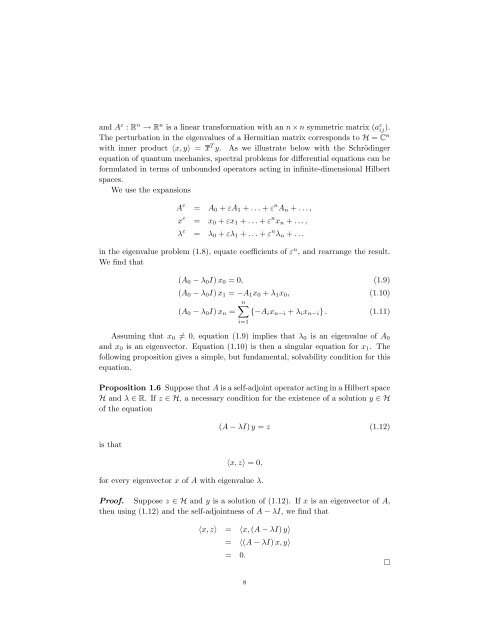Asymptotic Analysis and Singular Perturbation Theory
Asymptotic Analysis and Singular Perturbation Theory
Asymptotic Analysis and Singular Perturbation Theory
You also want an ePaper? Increase the reach of your titles
YUMPU automatically turns print PDFs into web optimized ePapers that Google loves.
<strong>and</strong> A ε : R n → R n is a linear transformation with an n × n symmetric matrix (a ε ij ).<br />
The perturbation in the eigenvalues of a Hermitian matrix corresponds to H = C n<br />
with inner product 〈x, y〉 = x T y. As we illustrate below with the Schrödinger<br />
equation of quantum mechanics, spectral problems for differential equations can be<br />
formulated in terms of unbounded operators acting in infinite-dimensional Hilbert<br />
spaces.<br />
We use the expansions<br />
A ε = A0 + εA1 + . . . + ε n An + . . . ,<br />
x ε = x0 + εx1 + . . . + ε n xn + . . . ,<br />
λ ε = λ0 + ελ1 + . . . + ε n λn + . . .<br />
in the eigenvalue problem (1.8), equate coefficients of ε n , <strong>and</strong> rearrange the result.<br />
We find that<br />
(A0 − λ0I) x0 = 0, (1.9)<br />
(A0 − λ0I) x1 = −A1x0 + λ1x0, (1.10)<br />
n<br />
(A0 − λ0I) xn = {−Aixn−i + λixn−i} . (1.11)<br />
i=1<br />
Assuming that x0 = 0, equation (1.9) implies that λ0 is an eigenvalue of A0<br />
<strong>and</strong> x0 is an eigenvector. Equation (1.10) is then a singular equation for x1. The<br />
following proposition gives a simple, but fundamental, solvability condition for this<br />
equation.<br />
Proposition 1.6 Suppose that A is a self-adjoint operator acting in a Hilbert space<br />
H <strong>and</strong> λ ∈ R. If z ∈ H, a necessary condition for the existence of a solution y ∈ H<br />
of the equation<br />
is that<br />
(A − λI) y = z (1.12)<br />
〈x, z〉 = 0,<br />
for every eigenvector x of A with eigenvalue λ.<br />
Proof. Suppose z ∈ H <strong>and</strong> y is a solution of (1.12). If x is an eigenvector of A,<br />
then using (1.12) <strong>and</strong> the self-adjointness of A − λI, we find that<br />
〈x, z〉 = 〈x, (A − λI) y〉<br />
= 〈(A − λI) x, y〉<br />
= 0.<br />
8
















